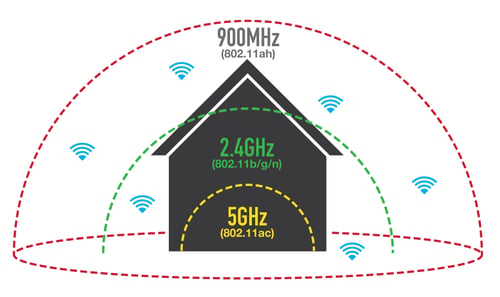Most of these devices communicate via wireless methods, but we have seen multiple protocols and frequencies used to enable this. They include Insteon, X10, ZigBee, Z-Wave, UPB, Bluetooth LE, KNX, AllJoyn and many, many more. Some of these protocols are backed by an alliance; some are fledgling protocols. The problem with the proliferation of IoT devices is that we’ve been left with a cluttered mess of cables, adapters, and specialized apps to control each device.
My personal home security system uses a special daughterboard to bridge the wireless sensors, while my garage door uses a special mini gateway to bridge the ZigBee communication, and similarly the timers and other Z-Wave enabled devices use a gateway hanging off my router to enable remote access through the Internet. Let’s be honest: that’s just too many protocols for one house to manage — especially when each of them has their own special management app.
The worst part is that all these protocols are incompatible, and all are fighting for dominance. But all is about to change with the introduction of 802.11ah.
This past month, the Institute of Electrical and Electronics Engineers (IEEE) published a draft of the 802.11ah standard, a new PHY and MAC design that intends to support extended range WiFi and IoT. 802.11ah is based on an amendment of the 802.11ac — a 2012 commercial release that is commonly used in residential WiFi gateways.
 Figure 1. 802.11ah promises to unify IoT and increase the range and speed of residential WiFi connections
Figure 1. 802.11ah promises to unify IoT and increase the range and speed of residential WiFi connections
Here are some quick key features in the IEEE draft for 802.11ah:
- It will operate between 755MHz and 928MHz, meaning it will still borrow some of the ultra-high-frequency band previously used by over-the-air television
- It promises to leverage the 900MHz spectrum to provide WiFi in hard-to-reach areas like backyards, out-buildings, attics, and large offices
- At its highest frequency, 802.11ah is expected to reach distances up to 1 kilometer (0.62 miles) between devices
- 802.11ah has been designed to encourage communication bursts at around 150kbps, which allows embedded devices to quickly transmit information and drop back to power-saving mode. This suits the demand required by most IoT devices, which are typically only used intermittently before reverting back to saving battery life
- The protocol has the theoretical potential of being able to transmit at up to 40Mbps. Put into context, this is about as fast as the wireless G-base stations that operated on 2.4Ghz spectrum, which have significantly shorter reach and much higher power requirements
But the IEEE isn’t the only organization attempting to solve the problem of connected devices with multiple protocols.
Google has also introduced a WiFi router last month called OnHub, which is more of an IoT gateway, as a means to clear up the clutter. It features a dual-band 802.11ac, WiFi, Bluetooth LE (Smart Ready), ZigBee, and Weave. Intel has a similar strategy to Google. It plans to introduce an IoT gateway with multiple supported M2M protocols, providing a unified interface and software that filters and aggregates data before it’s sent to the cloud.
In both the Intel and Google proposals, they suggest that to eliminate the headache and clutter caused by multiple protocols, we first need more hardware. IEEE’s proposal, alternatively, deals with the core issue of unifying the medium. It makes the task of supporting IoT for hardware manufacturers easier through augmenting the gateway’s 802.11ac stack, rather than requiring them to select from the many competing standards with dedicated radios and specialized software.
What an exciting time it is for IoT. I look forward to the final proposal and the eventual success of the 802.11ah standard, even if it just means I can finally clean up the clutter of cords and apps within my own house.



Submit a Comment